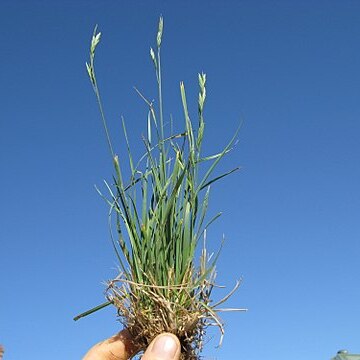Short, light green, rather stiffly erect, narrow-leaved perennial tufts, 30-75 cm. Leaf-sheath keeled above, ± densely hairy with long, soft hairs, sometimes reddish purple at base. Ligule 1.5-2.5 mm, denticulate, abaxially with long hairs near margins in lower ½. Leaf-blade 9-20 cm × 1.5-4.5 mm, with scattered to dense, long, soft, fine hairs; margins finely scabrid, tip fine, acute. Culm erect, internodes glabrous. Panicle 8-15 cm; branches ± compressed, erect, minutely hairy on angles. Spikelets 1-2 cm, narrow-oblong, light yellowish green. Glumes ± unequal, acute to acuminate, glabrous or sometimes with scattered short hairs, keel ciliate-scabrid; lower c. 4-4.5 mm, 3-5-nerved, upper 5-6 mm, 7-nerved. Lemma 8.5-10 mm, 7-9-nerved, keeled, with very short, silky, scattered, appressed hairs in upper ⅔, acute or shortly mucronate or with very short awn 0.5-0.8 mm. Palea ⅔ length of lemma and much narrower. Callus almost glabrous, with a few, very minute hairs. Rachilla with very short hairs. Anthers 0.2-0.5 mm in cleistogamous flowers, 1.5 mm in chasmogamous flowers. Caryopsis c. 6 × 2 mm.
More
Annual, caespitose. Culms 15–75 cm high. Leaves: basal sheaths densely pubescent to pilose; blade 5–26 cm long, 1–5 mm wide, usually densely pubescent or glabrous. Panicles erect, contracted, oblong or elliptic, 2–15.5 cm long; primary branches spreading. Spikelets erect, oblong or ovate or elliptic, (9–) 11–24 mm long, with 6–10 bisexual florets; pedicel 1.5–21 mm long. Glumes equal or unequal, keeled, with midnerve scaberulous towards apex and intercostal regions usually glabrous or puberulous; lower glume 5.5–8.3 mm long, 3–5 (–7)-nerved; upper glume 6.6–8.5 mm long, 7–9-nerved. Callus blunt, glabrous. Basal lemma strongly laterally compressed, 8–11 mm long, mucronate or apiculate, keeled, 7–9-nerved, usually glabrous or puberulous; apiculum subapical, 0.3–0.7 mm long. Palea c. 2/3–3/4 length of lemma, glabrous. Anthers 0.4–1 mm long.
A grass that grows for one or two years. It can have rhizomes or underground stems. It grows 60 cm tall. The leaf sheath is loose.

